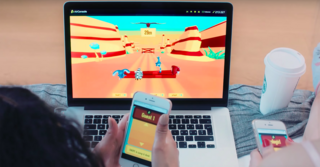 W
WAirConsole is a cloud-based video game console developed by Zurich-based startup N-Dream. It created the concept in January 2015, with around $1.4 million in initial capital. Soon after, N-Dream conducted a game development competition, where developers were encouraged to create their own game on the AirConsole platform.
 W
WThe Analogue Pocket is an upcoming FPGA-based handheld game console designed and manufactured by Analogue, Inc., announced on October 16, 2019 with release set for December 13, 2021. It is designed to play games designed for handhelds of the fourth, fifth and sixth generation of video game consoles.
 W
WThe APF Microcomputer System is a second generation 8-bit cartridge-based home video game console released in October 1978 by APF Electronics Inc. with six cartridges. The console is often referred to M-1000 or MP-1000, which are the two model numbers of the console. The APF-MP1000 comes built-in with the game Rocket Patrol. The APF-MP1000 is a part of the APF Imagination Machine.
 W
WThe Atari Mindlink is an unreleased video game controller for the Atari 2600, originally intended for release in 1984. The Mindlink was unique in that its headband form factor controls the game by reading the myoneural signal voltage from the player's forehead. The player's forehead movements are read by infrared sensors and transferred as movement in the game.
 W
WThe Atomiswave is a custom arcade system board and cabinet from Sammy Corporation. It is based on Sega's Dreamcast console. The Atomiswave uses interchangeable game cartridges and the cabinet's control panel can be easily switched out with different control sets, including dual joysticks, dual light guns and a steering wheel.
 W
WThe Bandai Super Vision 8000 is a home video game console released by Bandai in 1979 belonging to the second generation. The console can be directly connected to a TV.
 W
WBatterUP is a "24-inch foam-covered plastic" baseball bat-shaped controller manufactured for the personal computer, Sega Genesis, and the Super Nintendo Entertainment System by Sports Sciences Inc.
 W
WThe BBC Bridge Companion is an 8-bit video game console designed for teaching bridge, produced by BBC Enterprises Ltd. It was released in 1985 in the United Kingdom, retailing for £199.99.
 W
WThe Casio Loopy , subtitled My Seal Computer SV-100, is a 32-bit home video game console. Released exclusively in Japan in October 1995, it was unique in that the marketing for it was completely targeted to female gamers.
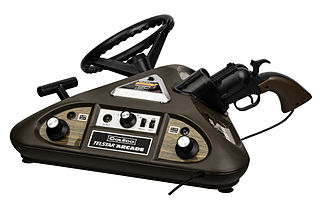 W
WThe Coleco Telstar Arcade, commonly abbreviated as Telstar Arcade, is a first-generation home video game console that was released in 1977 in Japan, North America and Europe by Coleco. It is the most advanced video game console in the Coleco Telstar series, based on the MOS Technology MPS-7600-00x chips series. Each of these chips is a full microcontroller with 512 ROM area.
 W
WThe Coleco Telstar Marksman, commonly abbreviated as Telstar Marksman, is a first-generation home video game console that featured a light gun. It was released by Coleco in 1978. Because it had a manufacturer-set number of games, it is considered a dedicated console. It was part of the Coleco Telstar series Pong-based home video game consoles; it is essentially a Coleco Telstar Colortron bundled with a "3 in 1" light gun and two shooting games. The Marksman light gun is a pistol that features an attachable stock and barrel. It is similar in this regard to the later-released Stack Light Rifle and the Sega Menacer. The elongated barrel included a simple aiming sight. In addition to the light gun, the system featured two paddle controllers built directly into the console. Its reported features included "on-screen digital scoring" and three different difficulty settings. It required two nine-volt batteries or Coleco's Perma Power AC adaptor to power the system.
 W
WThe DECO Cassette System was introduced by Data East in October 1980. It was the first standardised arcade system that allowed arcade owners to change games. Developed in 1979, it was released in Japan in 1980 and then North America in 1981.
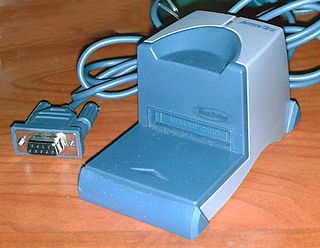 W
WDexDrive is a brand of game console memory card readers that allowed data to be accessed by a PC. The DexDrive products were made by now-defunct InterAct for use with PlayStation and Nintendo 64 memory cards. It was shipped to retail stores in January 1997.
 W
WThe Entex Select-a-game is a handheld game system released in 1981 by Entex Industries. Entex released six games for the device before they dropped support in 1982 in favor of the Entex Adventure Vision.
 W
WThe Epoch Game Pocket Computer is a second-generation handheld game console released by Epoch Co. in Japan in 1984 for 12,000 Japanese yen. It is also known as Pokekon and was one of the very few truly handheld systems to be released in the early 1980s, preceding the Game Boy by 5 years.
 W
WThe Gakken Compact Vision TV Boy is a second generation home video game console developed by Gakken and released in Japan in 1983 for a price of ¥8,800.
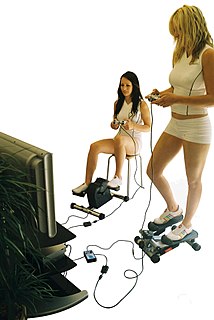 W
WGamercize is an example of an exergaming accessory, connecting exercise machines such as stationary cycles and steppers to video games consoles. These consoles are supported by the following variationsGZ Sport - Xbox, GameCube, PlayStation, PlayStation 2GZ Pro-Sport - Xbox 360, Wii, PlayStation 3 GZ PC-Sport - PC, Mac.
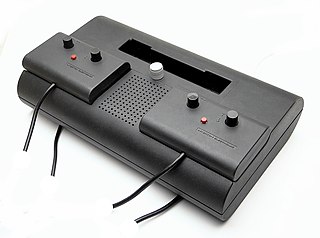 W
WThe Interton Video 2000 is a relatively rare dedicated first-generation home video game console that was released in 1975 by Interton in Germany. The console turns itself on automatically when a cartridge is inserted. This console was also one of the first cartridge-based consoles ever released in Europe.
 W
WThe Interton Video 2400 is a dedicated first-generation home video game console that was released in 1975 by Interton. It is the successor of the Interton Video 2000 and the predecessor of the Interton Video 2501. It could output only black and white. The consoles uses the AY-3-8500 chipset. The sound is played through an internal speaker, rather than the TV set.
 W
WThe Interton Video 2501 is a dedicated first-generation home video game console that was released by Interton in 1977. It is the successor of the Interton Video 2400 and the predecessor of the Interton Video 2800. It can output the games in color.
 W
WThe Interton Video 2800 is a dedicated first-generation home video game console that was released in 1977 by Interton. It could output only black and white. It is the successor of the Interton Video 2501 and the predecessor of the Interton Video 3000.
 W
WThe Interton Video 3000 is a dedicated first-generation home video game console that was released in Germany in 1976 by German manufacturer Interton and sold by Quelle. Due to the AY-3-8500 chipset from General Instrument, the console has six integrated games: Tennis, Football, Practice, Squash, Skeet and Moving target. It had a list price of 198 Deutsche Mark (DM).
 W
WThe Interton Video 3001 is a dedicated first-generation home video game console that was released in 1978 by Interton. It is a Pong clone console and the successor to the Interton Video 3000 and the predecessor of the Interton Video Computer 4000. It could output games in color.
 W
WThe J-Cart is a special ROM cartridge developed by Codemasters for the Sega Genesis console. It held not only the game data but also came with two additional gamepad ports. This effectively allowed four players to play simultaneously without any extra adapters. The first J-Cart game, Tennis All-Stars, was released in early 1994.
 W
WThe LeapFrog Didj is a handheld console made by LeapFrog Enterprises. The Didj was priced at $89.99 when it debuted on August 22, 2008. Its library mostly consists of educational software aimed for children based on licensed properties such as those from Disney, Nickelodeon, and Marvel.
 W
WThe Leapster Learning Game System is an educational handheld game console aimed at 5 to 10-11 year olds, made by LeapFrog Enterprises. Its games teach the alphabet, phonics, basic math, and art and animal facts to players. Along with a directional pad, the system features a touchscreen with a stylus pen that enables young users to interact directly with the screen. On February 5, 2008, LeapFrog announced the Leapster2 handheld device as a successor to the Leapster. The Leapster2 is essentially the previous system with an added USB port and SD card slot. These additions give the ability to play a downloaded full game or short game including the ability to log data on gameplay, such as what has been learned by the user or art created by the user. Downloadable games are not for sale.
 W
WThe LeapTV is an educational video game console developed by LeapFrog and released on October 20, 2014. The console consists of the main unit, a motion sensing camera, and a modifiable controller for different play styles. The console was available at Walmart, Target, Amazon, and Toys "R" Us.
 W
WThe Magnum Light Phaser is a light gun created in 1987 for the ZX Spectrum computer. A version was also released for the Commodore 64/128. It was Amstrad's last peripheral for the video game console. The Magnum Light Phaser in many ways resembles the Light Phaser, the Sega Master System light gun, released in 1986. It was a Sinclair-branded Far Eastern product which was included in promotional bundles such as the "James Bond 007 Action Pack", along with a small number of lightgun-compatible games.
 W
WThe MoMA Eve was a handheld gaming console presented by Via at E3 2004. It was supposed to play PC games as well as games designed for it. The player would have had to purchase a SIM Card to play purchased games on it. The buttons look like the buttons on an average video game controller with a D-pad on the left, four action buttons on the right, one Start button in the middle, and two analog sticks. It had a 533 MHz processor, a 20GB hard drive for games and movies, Wi-Fi, and a CF slot. It also had TV-OUT. The console encountered a trademark issue in mid-2004. The system was never released and is considered vaporware.
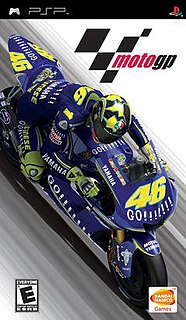 W
WMotoGP is a racing game released for the PlayStation Portable based on the 2005 and 2006 MotoGP seasons. MotoGP was developed by Namco Bandai Games and was released in 2006. The game received average reviews with most critics focusing towards the graphics and gameplay.
 W
WThe My Vision is a home video game console developed by Nichibutsu and released in Japan in 1983. The system was dedicated solely to playing video versions of popular board games. The console had no controllers; instead, players used a keyboard on the front of the console to input their actions.
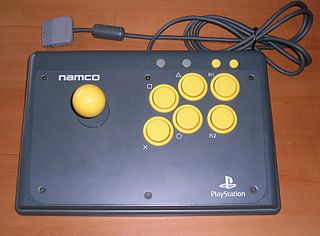 W
WThe Namco Arcade Stick is a joystick video game controller released by Namco in 1996 for the PlayStation.
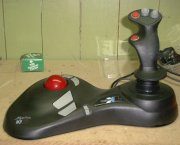 W
WThe Panther XL by Mad Catz is a joystick and trackball combination that is used to replace the keyboard and mouse for player movement in first-person shooter games like Quake and Unreal. it could also be used for flight simulators so players can point their ship in any direction with the trackball. Based on a patent by James Barnes of First-Person Gaming, the Panther XL used technology used in the Assassin 3D controller.
 W
WPlay is a monthly magazine produced by Future Publishing in the United Kingdom, which reports on Sony's PlayStation product range. It had been published by Imagine Publishing but closed in 2016. It was resurrected as a replacement for the official UK PlayStation magazine in May 2021.
 W
WPlayStation Magazine, also known by the acronym PSM, is an Italian video game magazine specializing in all Sony video game consoles and handheld gaming platforms. The magazine features previews, reviews, and cheat codes for Sony games.
 W
WThe Casio PV-1000 is a third-generation home video game console manufactured by Casio and released in Japan in 1983. It was discontinued less than a year after release.
 W
WThe Ricoh 2A03 or RP2A03 / Ricoh 2A07 or RP2A07 is an 8-bit microprocessor manufactured by Ricoh for the Nintendo Entertainment System video game console. It was also used as a sound chip and secondary CPU by Nintendo's arcade games Punch-Out!! and Donkey Kong 3.
 W
WOriginally known as VR-SHOOTER, the Sega Lock-On is a laser tag game developed by Sega and originally released in 1992. It was particularly popular in Hong Kong and South Korea. There were three versions of this system made, unofficially called Mark I, Mark II and Voice Command Lock-On. The Mark I and Mark II versions operated the same and differed in their overall appearance. Each system consists of a headset and a gun for each player, the aim being to shoot the opponent's headset. The headset required one 9-Volt battery while the gun required two C batteries. The Mark II headset used four AAA batteries instead of the single 9V one. Each gun and headset was able to select between two teams, A and B. A gun set to team A could only hit a headset set to team B and vice versa. This way friendly fire was not possible.
 W
WThe Seibu SPI System is Seibu Kaihatsu's custom arcade system board. The Seibu SPI system board uses interchangeable game cartridges, however, each cartridge is region specific, and must be paired with a board of the same region. Seibu SPI boards "update" when a game cartridge is changed. This process takes about 10 minutes to complete, and only has to be performed once after a cart change.
 W
WThe System 573 is a series of arcade system boards by Konami based on the original PlayStation. The hardware was used primarily for Konami's Bemani series of music video game arcades, most commonly the Dance Dance Revolution series introduced in 1998. The System 573 is available in two variants with analog and digital I/O boards, dubbed the Bemani System 573 Analog and Bemani System 573 Digital respectively, along with a third variant called the System 573 Satellite Terminal which allows for up to 8 cabinets to be networked to a central one.
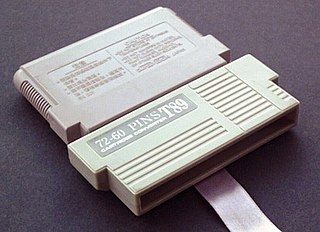 W
WThe T89 cartridge converter is a 60 to 72 pin adapter that allows NES owners to plug a 60-pin Famicom game into a 72-pin-based NES. The cartridge required the user to have the Famicom cartridge label facing the back as otherwise it would cause damage to the cart and/or system. There is a fabric tab on the converter to allow the easy removal of the device from the original front-loading NES and its subsequent top loader revision.
 W
WThe Tandy-12 is a computerized arcade game produced by the Tandy Corporation for sale in its Radio Shack chain of stores. The Tandy Corporation acquired Radioshack in 1970. The arcade game featured "12 challenging games of skill". However, most of these were based on luck and freestyle ability. The game had its packaging updated several times since its original release. It was packaged with the game unit itself, a manual, a cardboard playing board, and a set of plastic tokens. The manual is available online. The 1981 Tandy-12 Model number is 60-2159. The 1982 Tandy-12 Model number is 60-2159.
 W
WThe Telejogo is a dedicated first-generation home video game console that was released on August 2, 1977 by Philco and Ford in Brazil. It is a Pong clone console and the first video game console ever released in Brazil. In 1979, a successor called Telejogo II was released.
 W
WThe Telejogo II is a dedicated first-generation home video game console that was manufactured by Philco and Ford and released in 1979 in Brazil as the successor to the 1977 video game console Telejogo.
 W
WThe Telescore 750 is a dedicated first-generation home video game console manufactured and released by Groupe SEB in 1977, only in France for 100 Franc. Two revisions were released afterwards; the Telescore 751 in 1978, identical to the Telescore 750 but with two detachable game controllers and support for a lightgun sold separately, and the Telescore 752 in 1979, which was almost identical to the Telescore 751 but could also display games in color and had the lightgun included.
 W
WThe Turnir is a dedicated first-generation home video game console that was manufactured by the Ministry of the Electronics Industry and released in 1978 only in the Soviet Union. It was manufactured between 1978 and 1982 and is the only known Soviet video game console that uses the AY-3-8500 chipset from General Instrument. The price for the system varied from 150 Soviet rubles in 1978 to 96 rubles in the late 1980s. The console uses an integrated AC adapter with a voltage of 9 volt and has a mass of 2.5 kg.
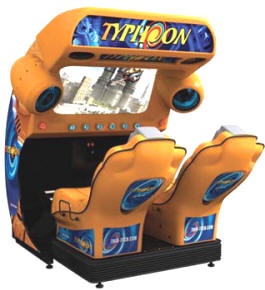 W
WTyphoon is a coin-operated media-based motion simulator created by Triotech. It is a 3D arcade machine with 2 seats for people to sit in including 15 films where it can shake and drop. The machine delivers up to 2G Forces of acceleration.
 W
WThe Visteon Dockable Entertainment System is a portable DVD player created by Visteon in 2006 for the US market at an MSRP of $1299 USD. The player is notable for containing officially licensed Game Boy Advance hardware, as Visteon partnered with Nintendo to announce the product at CES 2006. Initially due out in April, the product was then delayed to May before finally launching in July of that year. To celebrate the product's launch Visteon held a photography and writing contest.
 W
WWonderbook is an augmented reality peripheral for the PlayStation 3 console. The user holds a physical book-like object and stories come to life as the software displays content on the television's screen.
 W
WThe XaviXPORT, sold as the Domyos Interactive System in Europe in Decathlon stores, is a fitness-based home video game console developed by Japanese company SSD COMPANY LIMITED and released in the United States in 2004 during the sixth generation of video game consoles. The console uses cartridges and wireless controllers. The controllers are shaped like sports equipment, with users actions represented on the television screen through the use of sensors in the controllers. The MSRP for the XaviXPORT was USD $79.99 at launch. However, the system has been officially sold as low as $19.99 bundled with tennis or bowling in their 2013 Spring Cleaning sale. In 2013, Xavix's social media sites went silent, but the ecommerce site remained up until 2017 when the official domain expired.